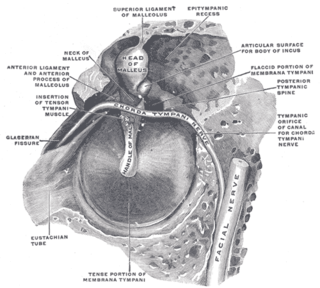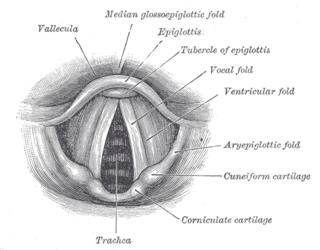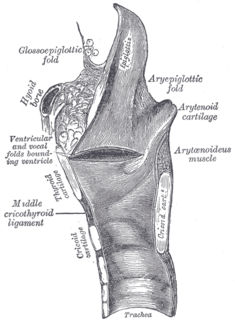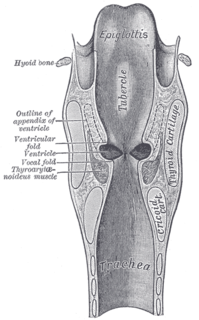Related Research Articles

The glottis is the opening between the vocal folds.

A commando is a combatant, or operative of an elite light infantry or special operations force using dedicated operation techniques.

The tibia, also known as the shinbone or shankbone, is the larger, stronger, and anterior (frontal) of the two bones in the leg below the knee in vertebrates, and it connects the knee with the ankle bones. The tibia is found on the medial side of the leg next to the fibula and closer to the median plane or centre-line. The tibia is connected to the fibula by the interosseous membrane of the leg, forming a type of fibrous joint called a syndesmosis with very little movement. The tibia is named for the flute tibia. It is the second largest bone in the human body next to the femur. The leg bones are the strongest long bones as they support the rest of the body.

The Commandos, also known as the British Commandos, were formed during the Second World War in June 1940, following a request from the Prime Minister of the United Kingdom, Winston Churchill, for a force that could carry out raids against German-occupied Europe. Initially drawn from within the British Army from soldiers who volunteered for the Special Service Brigade, the Commandos' ranks would eventually be filled by members of all branches of the British Armed Forces and a number of foreign volunteers from German-occupied countries. By the end of the war 25,000 men had passed through the Commando course at Achnacarry. This total includes not only the British volunteers, but volunteers from Greece, France, Belgium, Netherlands, Norway, Poland, and the United States Army Rangers, which were modelled on the Commandos.
Hemicorporectomy is a radical surgery in which the body below the waist is amputated, transecting the lumbar spine. This removes the legs, the genitalia, urinary system, pelvic bones, anus, and rectum. It is an extremely mutilating procedure recommended only as a last resort for people with severe and potentially fatal illnesses such as osteomyelitis, tumors, severe traumas and intractable decubiti in, or around, the pelvis. It has only been reported a few dozen times in medical literature.

A thyroglossal cyst is a fibrous cyst that forms from a persistent thyroglossal duct. Thyroglossal cysts can be defined as an irregular neck mass or a lump which develops from cells and tissues left over after the formation of the thyroid gland during developmental stages.

The neck dissection is a surgical procedure for control of neck lymph node metastasis from squamous cell carcinoma (SCC) of the head and neck. The aim of the procedure is to remove lymph nodes from one side of the neck into which cancer cells may have migrated. Metastasis of squamous cell carcinoma into the lymph nodes of the neck reduce survival and is the most important factor in the spread of the disease. The metastases may originate from SCC of the upper aerodigestive tract, including the oral cavity, tongue, nasopharynx, oropharynx, hypopharynx, and larynx, as well as the thyroid, parotid and posterior scalp.

Operation Roast was a military operation undertaken by British Commandos, at Comacchio lagoon in north-east Italy, during the Spring 1945 offensive in Italy, part of the Italian Campaign, during the final stages of Second World War.
A foerster clamp is a surgical clamp with a round eyelet. Also known as a sponge clamp, or sponge stick. Used for atraumatically grasping lung tissue in thoracic surgery. When grasping a surgical sponge in the jaws, Foerster clamps are commonly used for removing small amounts of fluids from the operative area and applying pressure to sites of bleeding. May also be used for tissue dissection. Invented by David William Foerster of Oklahoma City, Oklahoma, who pioneered sex change operations in the United States.

The chorda tympani is a branch of the facial nerve that originates from the taste buds in the front of the tongue, runs through the middle ear, and carries taste messages to the brain. It joins the facial nerve inside the facial canal, at the level where the facial nerve exits the skull via the stylomastoid foramen, but exits through a different route.

The laryngeal inlet is the opening that connects the pharynx and the larynx.

The middle pharyngeal constrictor is a fan-shaped muscle located in the neck. It is one of three pharyngeal constrictors. Similarly to the superior and inferior pharyngeal constrictor muscles, the middle pharyngeal constrictor is innervated by a branch of the vagus nerve through the pharyngeal plexus. The middle pharyngeal constrictor is smaller than the inferior pharyngeal constrictor muscle.

The superior pharyngeal constrictor muscle is a muscle in the pharynx. It is the highest located muscle of the three pharyngeal constrictors. The muscle is a quadrilateral muscle, thinner and paler than the inferior pharyngeal constrictor muscle and middle pharyngeal constrictor muscle.

The lingual nerve provides sensory (touch and taste) innervation to the anterior two thirds of the tongue. It is made of fibres from both the mandibular division of the trigeminal nerve (CN V3) and from the facial nerve (CN VII). The fibres from the mandibular nerve are for touch, and the ones from the facial nerve are for taste.

The anterior or lingual surface of the epiglottis is curved forward, and covered on its upper, free part by mucous membrane which is reflected on to the sides and root of the tongue, forming a median and two lateral glossoepiglottic folds; the lateral folds are partly attached to the wall of the pharynx.

The portion of the cavity of the larynx above the vestibular fold is called the laryngeal vestibule; it is wide and triangular in shape, its base or anterior wall presenting, however, about its center the backward projection of the tubercle of the epiglottis. It contains the vestibular folds, and between these and the vocal folds are the laryngeal ventricles.

The infraglottic cavity is the portion of the larynx below the laryngeal ventricles and the rima glottidis.
The pharyngeal aponeurosis, is situated between the mucous and muscular layers.
The Cincinnati Commandos were a professional indoor football team based in Cincinnati, Ohio. The team suspended operations for the 2013 season, with hope of returning in 2014. They began play in 2010 as an expansion team in the Continental Indoor Football League before moving to the United Indoor Football League in 2012. The Commandos then left the UIFL after winning Ultimate Bowl II and re-joined the CIFL, but never took the field after its announcement. The Commandos were the fifth arena or indoor football in Cincinnati, after the Cincinnati Rockers, Cincinnati Swarm, Cincinnati Marshals, and Cincinnati Jungle Kats. The owners of the Commandos are Dennis Whitman and Paul Napier. The Commandos played their home games at Cincinnati Gardens.

Lingual papillae are the small, nipple-like structures on the upper surface of the tongue that give it its characteristic rough texture. The four types of papillae on the human tongue have different structures and are accordingly classified as circumvallate, fungiform, filiform, and foliate. All except the filiform papillae are associated with taste buds.
References
- ↑ Commando Operation Archived 2016-03-03 at the Wayback Machine at Mondofacto online medical dictionary
| This surgery article is a stub. You can help Wikipedia by expanding it. |